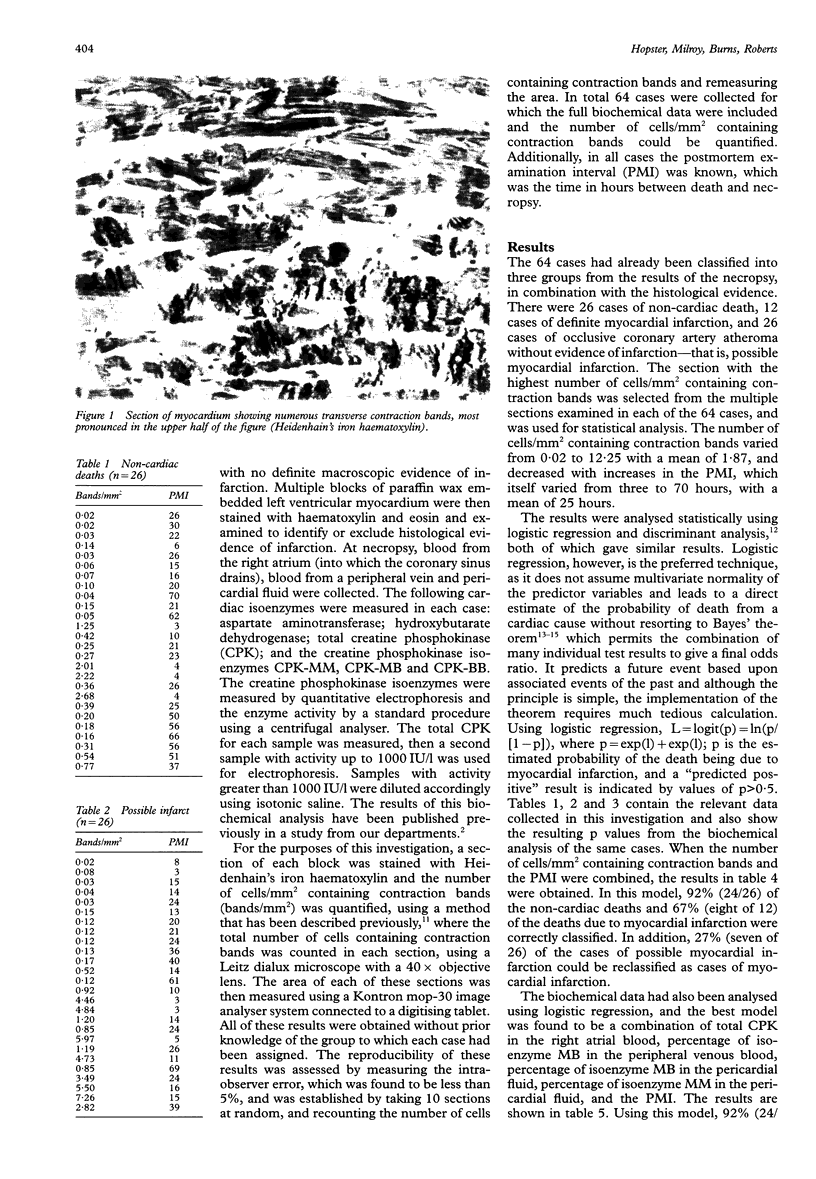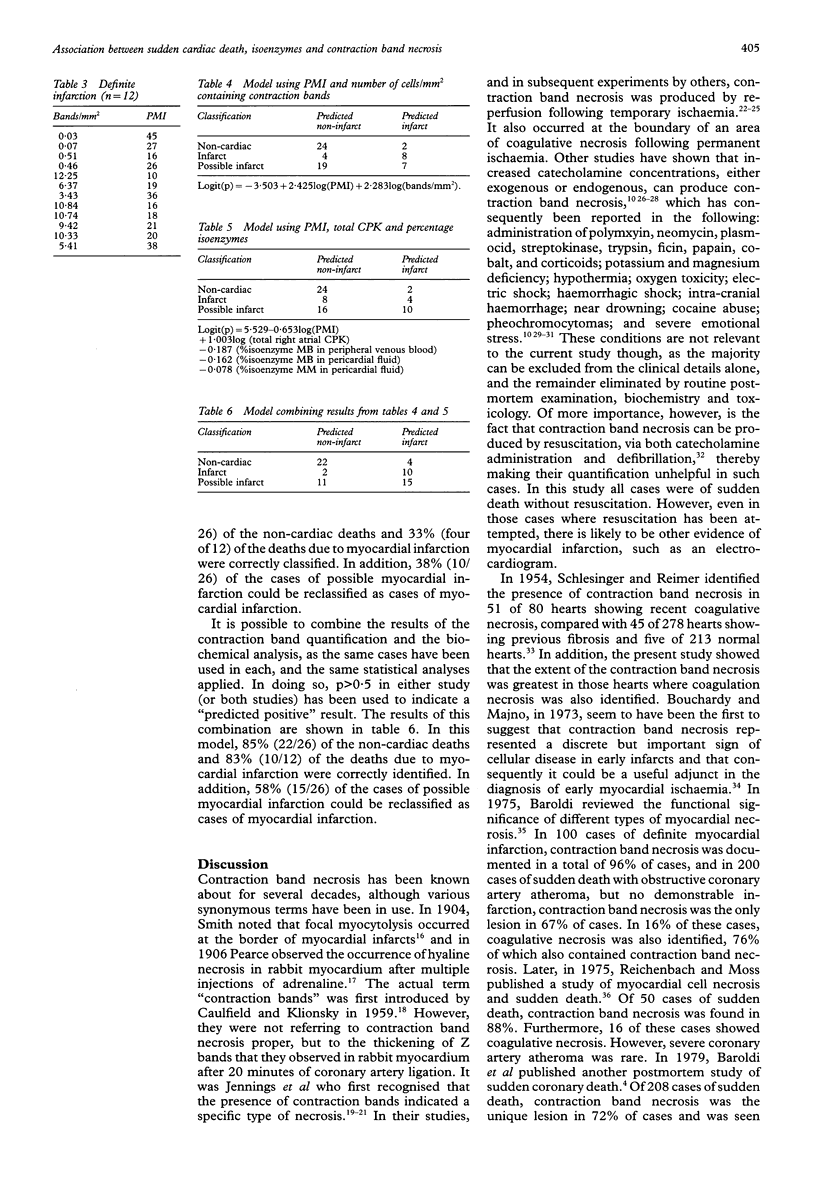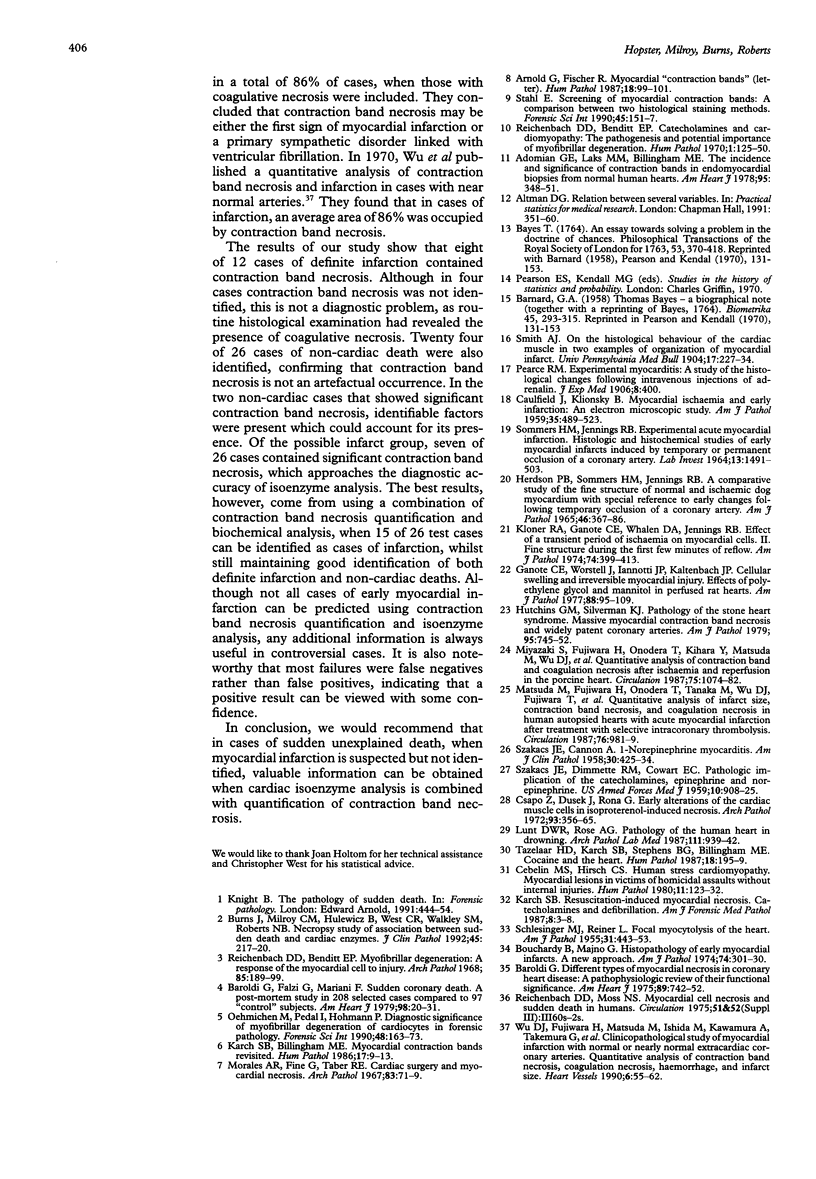Abstract
AIMS: To assess whether a quantitative analysis of myocardial contraction bands could aid the postmortem identification of early myocardial infarction, especially if used in conjunction with cardiac isoenzyme activities. METHODS: Sixty four coroner's necropsies were grouped by gross and histological findings into 26 cases of definite non-cardiac death, 12 cases of definite myocardial infarction and 26 cases in which there was occlusive coronary artery atheroma, but no demonstrable evidence of infarction. Using multiple sections of left ventricular myocardium stained with Heidenhain's iron haematoxylin, the number of myocardial cells containing contraction bands per unit area was quantified. The results were analysed statistically using logistic regression, and were then compared and combined with results from the statistical analysis of postmortem cardiac isoenzymes that had recently been undertaken on the same cases. RESULTS: The number of cells containing contraction bands per unit area was higher in cases of definite myocardial infarction compared with those of non-cardiac deaths. In addition, cases of occlusive coronary artery atheroma only could be identified, indicating the presence of early myocardial infarction. The accuracy of this identification could be improved by combining these results with the results from the statistical analysis of postmortem cardiac isoenzymes. CONCLUSION: The quantitative assessment of myocardial contraction band necrosis can provide useful additional information in cases of sudden death, where myocardial infarction is suspected but not identified on routine histological staining. The value of the information obtained is increased when used in conjunction with the postmortem measurement of cardiac isoenzyme activities.
Full text
PDF



Images in this article
Selected References
These references are in PubMed. This may not be the complete list of references from this article.
- Adomian G. E., Laks M. M., Billingham M. E. The incidence and significance of contraction bands in endomyocardial biopsies from normal human hearts. Am Heart J. 1978 Mar;95(3):348–351. doi: 10.1016/0002-8703(78)90366-6. [DOI] [PubMed] [Google Scholar]
- Arnold G., Fischer R. Myocardial "contraction bands". Hum Pathol. 1987 Jan;18(1):99–101. doi: 10.1016/s0046-8177(87)80205-8. [DOI] [PubMed] [Google Scholar]
- Baroldi G. Different types of myocardial necrosis in coronary heart disease: a pathophysiologic review of their functional significance. Am Heart J. 1975 Jun;89(6):742–752. doi: 10.1016/0002-8703(75)90189-1. [DOI] [PubMed] [Google Scholar]
- Baroldi G., Falzi G., Mariani F. Sudden coronary death. A postmortem study in 208 selected cases compared to 97 "control" subjects. Am Heart J. 1979 Jul;98(1):20–31. doi: 10.1016/0002-8703(79)90316-8. [DOI] [PubMed] [Google Scholar]
- Bouchardy B., Majno G. Histopathology of early myocardial infarcts. A new approach. Am J Pathol. 1974 Feb;74(2):301–330. [PMC free article] [PubMed] [Google Scholar]
- Burns J., Milroy C. M., Hulewicz B., West C. R., Walkley S. M., Roberts N. B. Necropsy study of association between sudden death and cardiac enzymes. J Clin Pathol. 1992 Mar;45(3):217–220. doi: 10.1136/jcp.45.3.217. [DOI] [PMC free article] [PubMed] [Google Scholar]
- CAULFIELD J., KLIONSKY B. Myocardial ischemia and early infarction: an electron microscopic study. Am J Pathol. 1959 May-Jun;35(3):489–523. [PMC free article] [PubMed] [Google Scholar]
- Cebelin M. S., Hirsch C. S. Human stress cardiomyopathy. Myocardial lesions in victims of homicidal assaults without internal injuries. Hum Pathol. 1980 Mar;11(2):123–132. doi: 10.1016/s0046-8177(80)80129-8. [DOI] [PubMed] [Google Scholar]
- Csapó Z., Dusek J., Rona G. Early alterations of the cardiac muscle cells in isoproterenol-induced necrosis. Arch Pathol. 1972 Apr;93(4):356–365. [PubMed] [Google Scholar]
- Ganote C. E., Worstell J., Iannotti J. P., Kaltenbach J. P. Cellular swelling and irreversible myocardial injury. Effects of polyethylene glycol and mannitol in perfused rat hearts. Am J Pathol. 1977 Jul;88(1):95–118. [PMC free article] [PubMed] [Google Scholar]
- HERDSON P. B., SOMMERS H. M., JENNINGS R. B. A COMPARATIVE STUDY OF THE FINE STRUCTURE OF NORMAL AND ISCHEMIC DOG MYOCARDIUM WITH SPECIAL REFERENCE TO EARLY CHANGES FOLLOWING TEMPORARY OCCLUSION OF A CORONARY ARTERY. Am J Pathol. 1965 Mar;46:367–386. [PMC free article] [PubMed] [Google Scholar]
- Hutchins G. M., Silverman K. J. Pathology of the stone heart syndrome. Massive myocardial contraction band necrosis and widely patent coronary arteries. Am J Pathol. 1979 Jun;95(3):745–752. [PMC free article] [PubMed] [Google Scholar]
- Karch S. B., Billingham M. E. Myocardial contraction bands revisited. Hum Pathol. 1986 Jan;17(1):9–13. doi: 10.1016/s0046-8177(86)80150-2. [DOI] [PubMed] [Google Scholar]
- Karch S. B. Resuscitation-induced myocardial necrosis. Catecholamines and defibrillation. Am J Forensic Med Pathol. 1987 Mar;8(1):3–8. doi: 10.1097/00000433-198703000-00002. [DOI] [PubMed] [Google Scholar]
- Kloner R. A., Ganote C. E., Whalen D. A., Jr, Jennings R. B. Effect of a transient period of ischemia on myocardial cells. II. Fine structure during the first few minutes of reflow. Am J Pathol. 1974 Mar;74(3):399–422. [PMC free article] [PubMed] [Google Scholar]
- Lunt D. W., Rose A. G. Pathology of the human heart in drowning. Arch Pathol Lab Med. 1987 Oct;111(10):939–942. [PubMed] [Google Scholar]
- Matsuda M., Fujiwara H., Onodera T., Tanaka M., Wu D. J., Fujiwara T., Hamashima Y., Kawai C. Quantitative analysis of infarct size, contraction band necrosis, and coagulation necrosis in human autopsied hearts with acute myocardial infarction after treatment with selective intracoronary thrombolysis. Circulation. 1987 Nov;76(5):981–989. doi: 10.1161/01.cir.76.5.981. [DOI] [PubMed] [Google Scholar]
- Miyazaki S., Fujiwara H., Onodera T., Kihara Y., Matsuda M., Wu D. J., Nakamura Y., Kumada T., Sasayama S., Kawai C. Quantitative analysis of contraction band and coagulation necrosis after ischemia and reperfusion in the porcine heart. Circulation. 1987 May;75(5):1074–1082. doi: 10.1161/01.cir.75.5.1074. [DOI] [PubMed] [Google Scholar]
- Morales A. R., Fine G., Taber R. E. Cardiac surgery and myocardial necrosis. Arch Pathol. 1967 Jan;83(1):71–79. [PubMed] [Google Scholar]
- Oehmichen M., Pedal I., Hohmann P. Diagnostic significance of myofibrillar degeneration of cardiocytes in forensic pathology. Forensic Sci Int. 1990 Dec;48(2):163–173. doi: 10.1016/0379-0738(90)90109-c. [DOI] [PubMed] [Google Scholar]
- Reichenbach D. D., Benditt E. P. Myofibrillar degeneration. A response of the myocardial cell to injury. Arch Pathol. 1968 Feb;85(2):189–199. [PubMed] [Google Scholar]
- SCHLESINGER M. J., REINER L. Focal myocytolysis of the heart. Am J Pathol. 1955 May-Jun;31(3):443–459. [PMC free article] [PubMed] [Google Scholar]
- SOMMERS H. M., JENNINGS R. B. EXPERIMENTAL ACUTE MYOCARDIAL INFARCTION; HISTOLOGIC AND HISTOCHEMICAL STUDIES OF EARLY MYOCARDIAL INFARCTS INDUCED BY TEMPORARY OR PERMANENT OCCLUSION OF A CORONARY ARTERY. Lab Invest. 1964 Dec;13:1491–1503. [PubMed] [Google Scholar]
- SZAKACS J. E., CANNON A. L-Norepinephrine myocarditis. Am J Clin Pathol. 1958 Nov;30(5):425–434. doi: 10.1093/ajcp/30.5.425. [DOI] [PubMed] [Google Scholar]
- SZAKACS J. E., DIMMETTE R. M., COWART E. C., Jr Pathologic implication of the catechol amines, epinephrine and norepinephrine. U S Armed Forces Med J. 1959 Aug;10:908–925. [PubMed] [Google Scholar]
- Ståhl E. Screening of myocardial contraction bands: a comparison between two histological staining methods. Forensic Sci Int. 1990 Mar;45(1-2):151–157. doi: 10.1016/0379-0738(90)90232-n. [DOI] [PubMed] [Google Scholar]
- Tazelaar H. D., Karch S. B., Stephens B. G., Billingham M. E. Cocaine and the heart. Hum Pathol. 1987 Feb;18(2):195–199. doi: 10.1016/s0046-8177(87)80338-6. [DOI] [PubMed] [Google Scholar]
- Wu D. J., Fujiwara H., Matsuda M., Ishida M., Kawamura A., Takemura G., Kida M., Uegaito T., Fujiwara T., Kawai C. Clinicopathological study of myocardial infarction with normal or nearly normal extracardiac coronary arteries. Quantitative analysis of contraction band necrosis, coagulation necrosis, hemorrhage, and infarct size. Heart Vessels. 1990;6(1):55–62. doi: 10.1007/BF02301880. [DOI] [PubMed] [Google Scholar]



